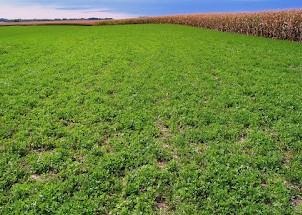By Jeff Coulter
Alfalfa provides many benefits to the corn crops that follow it, with the most notable being higher yield and reduced need for nitrogen (N) application compared to when it is grown in other rotations.

Photo: Matt Yost
Across 15 years at one location in southwestern Wisconsin and 21 and 30 years at two locations in northern Iowa, grain yield of first-year corn following alfalfa averaged 8 to 18% greater than that of continuous corn and 0 to 8% greater than that of corn following soybean (Mallarino and Ortiz-Torrez, 2006; Stanger and Lauer, 2008).
Additionally, grain yield of second-year corn following alfalfa averaged 0 to 8% greater than that of continuous corn, but 2 to 8% less than that of corn following soybean. Higher yields for first-year corn following alfalfa, and sometimes second-year corn following alfalfa in these experiments may have been due to improved soil aggregation and soil infiltration rate, and a reduction in soil compaction, soil- and residue-borne pathogens, and insect pests.
Alfalfa typically reduces the N application requirement for the two crops of corn that follow it. On medium (loamy) and fine (clayey) textured soils where alfalfa stands are two years or older when terminated, N application often does not increase grain yield of first-year corn following alfalfa, and it increases grain yield of second-year corn following alfalfa about one-half of the time. Nitrogen guidelines for first- and second-year corn following alfalfa are available at https://z.umn.edu/fertilizingcorn.
Effective alfalfa termination
Alfalfa that has been inadequately terminated is highly competitive with young corn plants for water and nutrients. Therefore, it important for alfalfa to be effectively terminated prior to corn emergence.
For effective termination of alfalfa with herbicide in the fall or spring, alfalfa regrowth should be at least 4 to 6 inches prior to herbicide application, otherwise there may be poor herbicide translocation to roots. Tillage should typically be delayed until at least 3 to 4 days after herbicide application, although some herbicide labels require a longer interval before tillage. These requirements can cause a delay in corn planting when alfalfa is terminated with herbicide in the spring.
Termination of alfalfa in the fall rather than spring can result in earlier release of N to the following corn crop, along with earlier drying and warming of soil in the spring. However, termination of alfalfa in the fall results in less cover to protect against soil erosion during the winter if tillage is used. Moreover, termination in the fall does not provide farmers with the option to assess the stand in the spring and determine whether alfalfa could be productive for another year.
Alfalfa can be terminated using herbicides, tillage, or both. Fall herbicide applications to terminate alfalfa should occur before the first killing freeze. A highly effective herbicide option for fall termination of alfalfa is 2,4-D alone or tank-mixed with dicamba. If grasses are present with alfalfa, a good option is to tank-mix glyphosate with 2,4-D. High rates of glyphosate alone often result in only partial kill of alfalfa (60 to 90% kill with fall applications, or 40 to 80% kill with spring applications).
Tillage implements such as a chisel plow with overlapping sweeps or a moldboard plow, which completely cut off all alfalfa roots, are effective at terminating alfalfa, but may not be suitable in some fields due to soil erosion. Tillage implements that do not completely cut off all alfalfa roots will be unable to provide complete alfalfa termination unless herbicide is applied before tillage.
Source : umn.edu